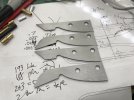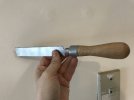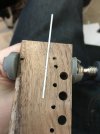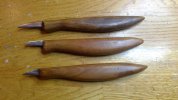You are using an out of date browser. It may not display this or other websites correctly.
You should upgrade or use an alternative browser.
You should upgrade or use an alternative browser.
Whittling/chip carving knife geometry
- Thread starter Scott H
- Start date
I hadn't thought about that really yet... I am making a pair of knives (chip carving + stab knife) for myself and a pair for a friend as a surprise gift, that is as far as I have thought ahead. I am not planning on making a lot of them for general sale or anything, but I could probably make a few more. If this batch turns out well I could do one in a different handle wood. I could also do a full tang version to add to the weight.
Here are some progress updates.
I have the blade blanks shaped and drilled for the four knives I am making in this batch. They still need to be beveled and then heat treated. I am going to use corby bolts on these knives for an extra level of mechanical fastening and simplicity during assembly. Getting the counterbores for them aligned correctly is going to be interesting, though, unfortunately most of the inexpensive piloted counterbores I can find are sized for screw tap drill sizes and not the round numbers I need which are 1/4" counterbore and 3/16" pilot.
Additionally, today I made a 1/16" thick slotting saw for making the kerf to mate the half-tang blades to their handles. It is just soft O1 tool steel from the same stock as the blades. It just fits in a normal file handle -- I used the screw-in type -- which is a time saving trick I learned from @creasman 's float build thread (Although he then went on to make the handles himself, too.) I also realized I might be able to use it to make thicker miter spline kerfs for boxes or picture frames. It can be used by just clamping the handle stock to be sawn in a vise with jaws that are flush to each other & aligned with the slot you want to make. You use the tops of the jaws as a reference surface for your cut, I put tape over them just to limit scratching. It can tear out a bit on the close side during use but because of the shape of the handles that is not a big problem, that material will be removed.
There is no set to the teeth so I guess we will see if I get binding on pieces that want to grab it instead of pull apart as they are sawn in half. The test piece I did first seemed to want to pull apart instead so it was not a problem. Once clamped again the results are extremely good.
The one complaint I have with it is it cuts very slowly. It is 8 TPI, I might go far lower if I was to make another one.
I have the blade blanks shaped and drilled for the four knives I am making in this batch. They still need to be beveled and then heat treated. I am going to use corby bolts on these knives for an extra level of mechanical fastening and simplicity during assembly. Getting the counterbores for them aligned correctly is going to be interesting, though, unfortunately most of the inexpensive piloted counterbores I can find are sized for screw tap drill sizes and not the round numbers I need which are 1/4" counterbore and 3/16" pilot.
Additionally, today I made a 1/16" thick slotting saw for making the kerf to mate the half-tang blades to their handles. It is just soft O1 tool steel from the same stock as the blades. It just fits in a normal file handle -- I used the screw-in type -- which is a time saving trick I learned from @creasman 's float build thread (Although he then went on to make the handles himself, too.) I also realized I might be able to use it to make thicker miter spline kerfs for boxes or picture frames. It can be used by just clamping the handle stock to be sawn in a vise with jaws that are flush to each other & aligned with the slot you want to make. You use the tops of the jaws as a reference surface for your cut, I put tape over them just to limit scratching. It can tear out a bit on the close side during use but because of the shape of the handles that is not a big problem, that material will be removed.
There is no set to the teeth so I guess we will see if I get binding on pieces that want to grab it instead of pull apart as they are sawn in half. The test piece I did first seemed to want to pull apart instead so it was not a problem. Once clamped again the results are extremely good.
The one complaint I have with it is it cuts very slowly. It is 8 TPI, I might go far lower if I was to make another one.
Attachments
Last edited:
@mdbuntyn The top counterbore I can do just by clamping the piece in place I think and doing the drill order you specified, the problem is for the corby bolts you have to counterbore the exit side of the 3/16" hole too. I am thinking what I will do is not touch the table height + drill through to scrap when drilling the 3/16" hole. Then I can put a short alignment pin in the 3/16" hole in the scrap and flip the handle to do the 1/4" hole on the other side and things should be more or less still indexed.
This is the type of feature I am trying to accomplish, the better the alignment the fewer cosmetic gaps in the ends of the pins.
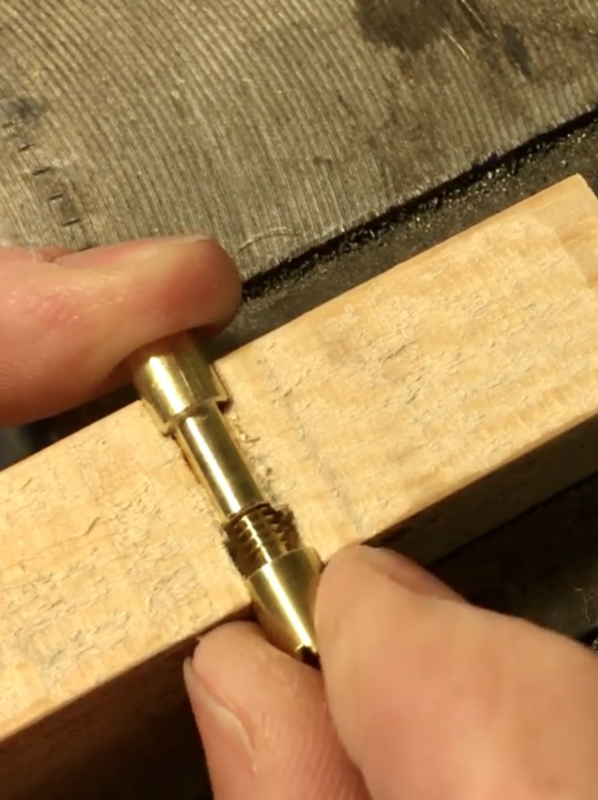
EDIT: Actually I may drill all the 3/16" holes first, because I have to align them with the 3/16" holes on the blade tangs, and then do all the counterbores at once using an indexing pin because my drill press has a very primitive depth stop and swapping bits in the chuck would lose the depth setting anyway.
This is the type of feature I am trying to accomplish, the better the alignment the fewer cosmetic gaps in the ends of the pins.

EDIT: Actually I may drill all the 3/16" holes first, because I have to align them with the 3/16" holes on the blade tangs, and then do all the counterbores at once using an indexing pin because my drill press has a very primitive depth stop and swapping bits in the chuck would lose the depth setting anyway.
Last edited:
Scott, I regularly do counterbores to existing holes on the drill press like this:
1. Chuck the bit that made the hole
2. Locate the workpiece using that bit and clamp with two clamps (autoclamps are nice here)
3. Change to c’bore bit and drill to depth
1. Chuck the bit that made the hole
2. Locate the workpiece using that bit and clamp with two clamps (autoclamps are nice here)
3. Change to c’bore bit and drill to depth
Are you going to sell them? Let me know If you make one of a dense exotic wood.
Other than blade geometry the big difference in the Barton is a nice dense wood. The Pfeil handle is soft wood and very light. I use it as a marking knife.
LATEST FOR SALE LISTINGS
-
SOLD -- $75: Gast moa v113 Vacuum Pump Veneer, 60" bag and board
- Started by peterdnight
- Replies: 1
-
GONE: Gladiator 5 cleats, 10 hangers, Paper Towel and Shelf
- Started by peterdnight
- Replies: 3
-
SOLD -- $100 Makita mac700 portable air + grex pin nailer + 2 others + 50' hose
- Started by peterdnight
- Replies: 1
-
-

